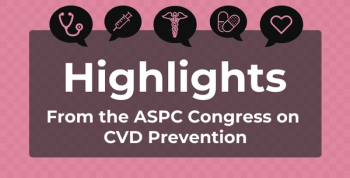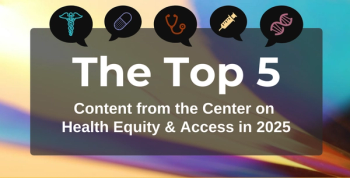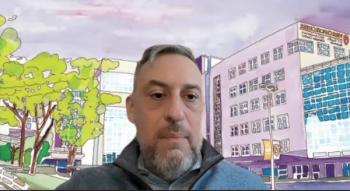
An Inside Look at Disparities in Lung Cancer Care for At-Risk Populations
On World Lung Cancer Day, we explore current guidelines for lung cancer screening in the United States, implications of the COVID-19 pandemic, and disparities in mortality and access to care by race and socioeconomic status.
As health care utilization experienced marked
In examining these delays, the impact on underserved communities and at-risk populations across the United States cannot be understated, as
Although early cancer screening and diagnosis provides patients with the best chance of positive outcomes, eligibility for screening, particularly
Serving as the
In fact, these concerns were the focus of recently
- Yearly low-dose computed tomography (LDCT) scans for people aged 50 to 80 years old, rather than starting at 55
- Individuals with 20 pack-years of smoking history now eligible, expanding from 30 pack-years
Reviewing the potential impact of these updated guidelines, M. Patricia Rivera, MD, professor of medicine, Division of Pulmonary Diseases and Critical Care Medicine, director, Multidisciplinary Lung Cancer Screening Program, and codirector, North Carolina Lung Screening Registry, at University of North Carolina at Chapel Hill, discussed in an email exchange with AJMC® what will be achieved and what unmet needs persist in managing lung cancer care disparities.
Are the Updated Guidelines Enough?
“The new recommendations of lowering the age and pack year requirement actually results in a higher relative increase in eligibility for women versus men, and for Blacks, Hispanics, and Native Americans versus whites,” said Rivera, who also served as a coauthor of an editorial published in
Citing another study published in
“It is expected that now 14.5 million US adults will be eligible for screening, with the 2013 recommendations it was 8 million. So, I think it's like an 81% increase of individuals–many more patients are now eligible,” said Rivera. “But the barriers still remain–just because you've lowered the age and the smoking history doesn't mean that the rate is going to increase. It means you've improved eligibility or access to lung cancer screening by eligibility, but not necessarily access to care.”
Ultimately, there are several underlying factors contributing to the inequities present in lung cancer care. In assessing one of the major
Deriving data from the Surveillance, Epidemiology and End Results program on Black and White patients diagnosed with NSCLC from 2004 to 2016, results indicated that Black patients with NSCLC who lived in the most segregated US counties were 49% more likely to be diagnosed at an advanced stage, compared with those living in the least segregated counties—a trend that was not found in White patients.
In addition to being more likely than White patients of being diagnosed at an advanced stage, despite having lower incidence overall, Black patients from highly segregated counties who were diagnosed with NSCLC at an early stage were found to be 47% less likely to receive surgery.
Multiple Reasons Underpinning Disparities
Addressing these disparities in surgery, corresponding study author Kei Suzuki, MD, assistant professor of Surgery, Boston University School of Medicine, told AJMC® that while the study was not designed to identify the details and causes of the association, he and fellow authors consider reasons for the link to be multifactorial.
“This could be due to system issues such as access to care—could be an issue on the providers’ side as they may be less likely to recommend surgery for Black patients,” Suzuki said via email. “This could be due to factors on the patients’ side, whether that be mistrust or that patients’ physiologic condition may not allow for surgery….using our local data with patients being seen at Boston Medical Center, we have further shown association with residential segregation in the form of
Perceiving updates to the USPSTF lung cancer screening guidelines as an important step in improving screening of at-risk populations, Suzuki noted that further research on risk factors is warranted, with another significant issue residing in screening uptake.
“Published screening rate/uptake in the country is in the range of 5% to 10%, meaning of those who meet the criteria, only a handful are actually receiving the screening LDCT scans. It’s one thing to expand the criteria, but an unanswered question remains: how do we better screen those who meet the criteria?”
Closing the Medicaid Screening Coverage Gap, Potential of Targeted Screening
As Rivera noted, there are several issues contributing to the lack of adherence nationwide to the USPSTF lung cancer screening guidelines, namely endorsement from prominent health care organizations and socioeconomic barriers such as insurance status.
Medicare is currently reviewing the updated USPSTF guidelines, and had endorsed screening in 2015, but for Medicaid, where recipients are
“There are [9] states that did not expand the Medicaid coverage for lung cancer screening. So, we have a large number of individuals in this country at risk for lung cancer because of smoking, who are either uninsured or underinsured with Medicaid and may be in an area where Medicaid doesn't cover—that remains a significant barrier within our health care system,” said Rivera.
With disparities in screening access potentially exacerbated by the updated guidelines due to the lack of applicability for a significant proportion of US residents covered by Medicaid, a recent
Endorsed by the International Association for the Study of Lung Cancer (IASLC), the review was based on findings of the
Speaking with AJMC®, Giorgio Scagliotti, past president and interim chief science officer, IASLC, and professor of Medical Oncology, University of Turin School of Medicine, highlighted that while screening recommendations focus primarily on current or former heavy smokers and age, there is growing evidence suggesting that risk factors such as family history of cancer or pneumonia, occupational exposures, and ethnicity are paramount in determining risk of lung cancer.
“Early-stage lung cancer can be managed with less complex, less costly clinical pathways than when it is diagnosed at later stages,” said Scagliotti via email. “As lung cancer progresses, health care costs rise from increased frequency of hospital admissions, additional rounds of treatment, additional care requirements and greater likelihood of palliative care.”
As underserved populations and people of lower socioeconomic status have been shown in data to be less likely to participate in cancer screening programs, the report assessed barriers that patients may face and opportunities for reform in 3 key areas:
- Increasing information and awareness
- Reducing physical and financial barriers to access
- Dismantling psychological and social barriers that prevent attendance at screening
“Screening with LDCT technology is the next big opportunity to increase survival from cancer, and wide scale implementation will bring us closer to our goal of eliminating lung cancer as a cause of death,” added Scagliotti.
Catching Cancer Earlier May Warrant Federal Intervention
Although a scaled LDCT screening approach would be optimal in expanding reach to high-risk populations, Rivera noted that simply revising guidelines to include requirements such as shared decision-making would potentially exacerbate
“In thinking of strategies that might expedite workflow, doing televisits of shared decision-making prior to patients coming in to see their doctors can be very helpful,” suggested Rivera. “But probably one of the most important interventions is that health care systems really need to provide the resources like the nurse navigators that can help facilitate the screening process. And in addition to navigators, community navigators deploying nurse navigators into communities to reach
Ultimately, Scagliotti, Rivera, and Suzuki all agree that to make a significant impact on lung cancer care disparities, federal intervention from policymakers is needed.
In fact, Rivera said that similar action was taken decades ago for breast and cervical cancer, in which federal mandates, such as the
“We need state involvement and individual state mandates like expansion of Medicaid across all states, so that all individuals have a chance to access this important preventive service,” added Rivera.
In looking at recent data on rates of screening across the United States per state, Kentucky has the
In response, the state has implemented a very aggressive lung cancer screening initiative that Rivera noted was spearheaded years ago primarily through family practice physicians. Through this initiative, Kentucky’s lung cancer screening rate rose to 15% in 2018, vastly greater than North Carolina, where the screening rate was 4% in the same year, underscoring potentially undiagnosed and advancing lung cancers.
“By having these initiatives that get screening into the communities where it's needed most and learning/trying to mimic or expand those kinds of initiatives across other states can be very helpful,” she concluded.
Newsletter
Stay ahead of policy, cost, and value—subscribe to AJMC for expert insights at the intersection of clinical care and health economics.








































